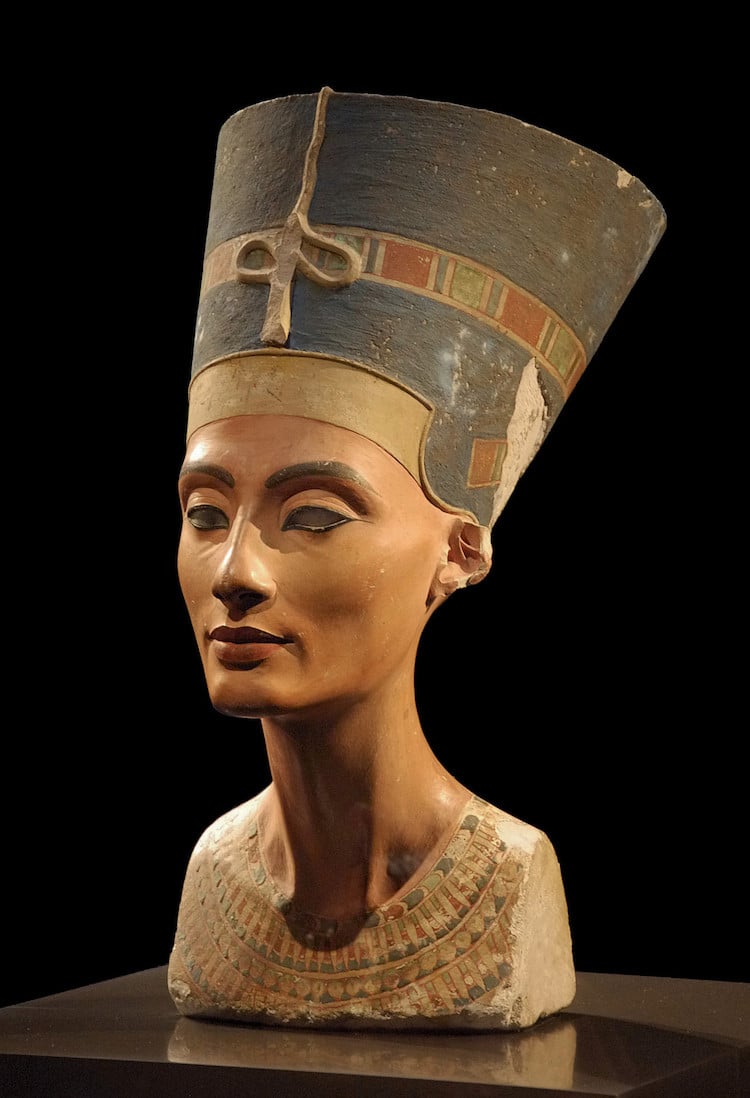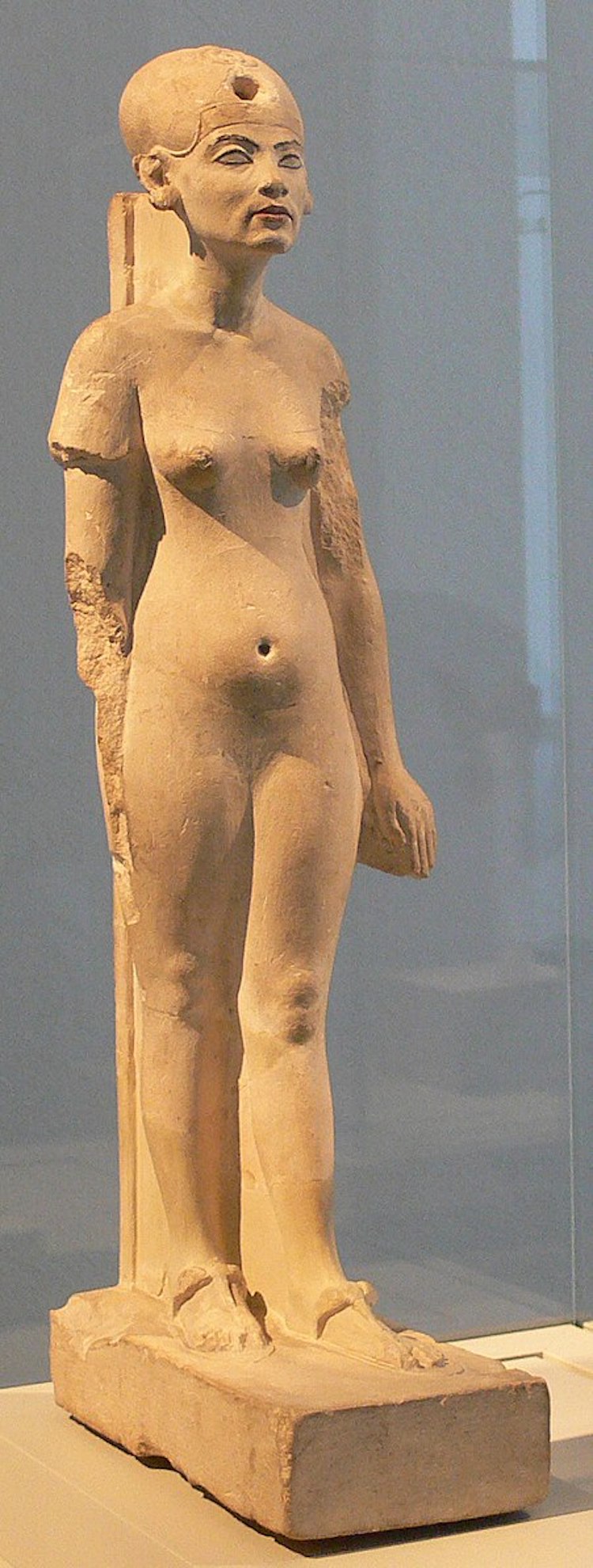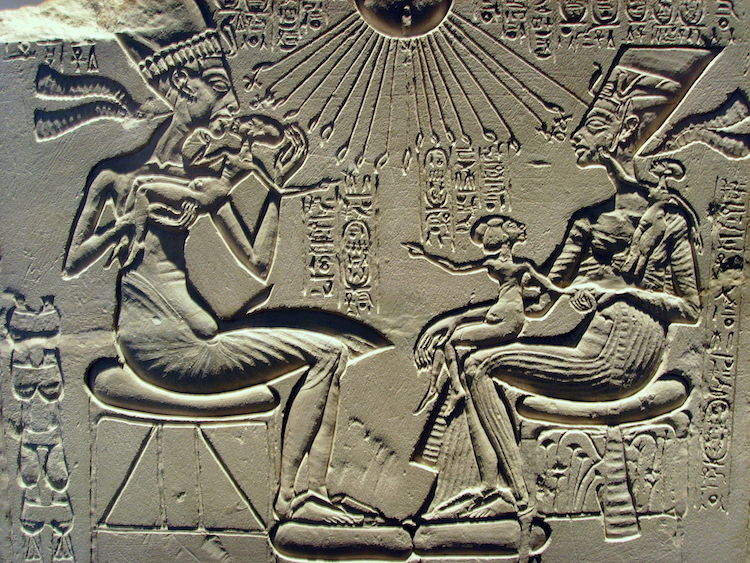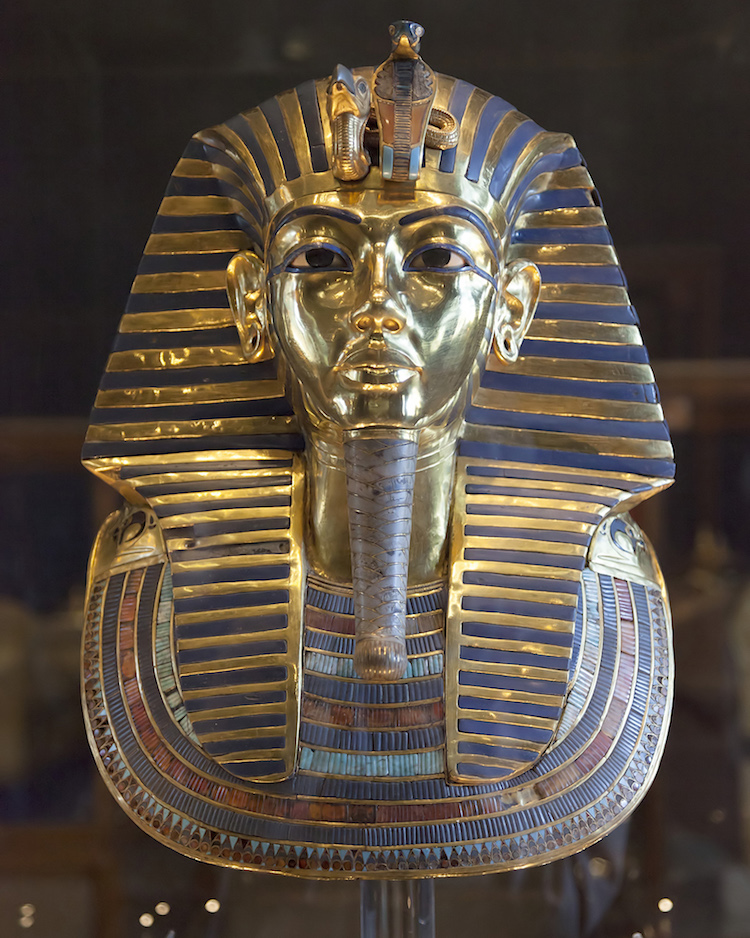https://mymodernmet.com/ancient-egypt-queen-nefertiti/
10 Facts About the Ancient Egyptian Queen Nefertiti

Bust of Nefertiti, Queen Consort of Akhenaten, 18th Dynasty, Egypt (Photo: Wikimedia Commons)
The bust of Nefertiti is one of the most famous icons of Ancient Egypt, yet the queen herself is still shrouded in mystery and intrigue. As consort to Pharaoh Akhenaten, the couple ruled from 1353 to 1336 BCE during one of the most contentious periods of Egypt's cultural history. At this time, Pharaoh Akhenaten remodeled Egypt's religion around the worship of the sun god Aten and moved the empire's capital to Amarna.
Although not pharaoh herself, Nefertiti's name has persisted because she held a uniquely influential role as wife and queen, which we see in surviving depictions of her. Historians have gleaned that Nefertiti was a major proponent of Akhenaten's religious and cultural movement. She represented the female aspect of Aten while her husband represented the male—and both acted as a bridge between Aten and the Egyptian people. The Nefertiti bust is identified as her likeness because of the characteristic crown, which she wears in all other inscribed depictions of her. The limestone sculpture was believed to have been completed by the artist Thutmose in 1345 BCE. Upon its discovery in 1912, the portrait has immortalized Nefertiti as the symbol of ideal feminine beauty.
Despite the little surviving evidence we have of Nefertiti, there is enough to build a picture of the remarkable woman captured in the bust. To gain a more in-depth understanding of queen Nefertiti, read on to learn ten facts about her life.

Late Amarna-era relief depicting Nefertiti (Photo: Keith Schengili-Roberts via Wikimedia Commons)
Here are 10 facts about the Ancient Egyptian Queen Nefertiti.
Nefertiti was a teenage queen.
Unsurprisingly for the era, Nefertiti was fifteen when she married sixteen-year-old Amunhotep IV. Five years into his reign, the pharaoh began his religious movement and renamed himself Akhenaten.
Akhenaten and Nefertiti built a new city.
With the foundation of their new monotheistic religion worshipping the sun god Aten, Nefertiti and Akhenaten further separated themselves from the "old reign" of Ancient Egypt and built a new capital city named Amarna.
Nefertiti might have been of royal heritage.
Nefertiti's family tree is mostly conjecture with two prevailing theories. Some historians believe her father to be Ay, who was an important advisor to several pharaohs, including Nefertiti's future husband. (Ay even became pharaoh himself after King Tut's death in 1323 BCE.) Other academics speculate that Nefertiti was a princess from the Mittani kingdom in northern Syria.
We do know that Nefertiti had a sister named Mutbenret (or Mutnodjemet), who is mentioned in the surviving art of Amarna.

Statuette of Nefertiti and Akhenaten (Photo: Rama via Wikimedia Commons)
She held many titles.
Like most royalty, Nefertiti held many titles during her time in power, including:
- Hereditary Princess
- Great of Praises
- Lady of Grace
- Sweet of Love
- Lady of the Two Lands
- Main King's Wife
- His beloved
- Great King's Wife
- Lady of all Women
- Mistress of Upper and Lower Egypt

Standing-striding figure of Nefertiti (Photo: Andreas Praefcke via Wikimedia Commons)
Nefertiti lived up to her name.
Nefertiti was born in 1370 BCE in the Egyptian city of Thebes. Her name in English means "the beautiful woman has come." When she and her husband Akhenaten initiated the shift in Egypt's religion, Nefertiti adopted the additional name of Neferneferuaten. Altogether, her full name means "beautiful are the beauties of Aten, a beautiful woman has come." According to the bust she left behind, Nefertiti had beauty in spades.

Nefertiti worshipping Aten (Photo: Jon Bodsworth via Wikimedia Commons)
She ruled over the wealthiest period of Ancient Egyptian history.
Akhenaten and Nefertiti ruled over the possibly wealthiest period in Ancient Egyptian history—which was perhaps the fuel to Akhenaten's vision. During his reign, the new capital of Amarna achieved an artistic boom, distinct from any other era in Egypt. The Amarna style showed movement and figures of more exaggerated proportions, with elongated hands and feet. The depictions of Akhenaten during this time give him distinctly feminine attributes with wide hips and prominent breasts.
She was a powerful wife.
Nefertiti was the favored consort, or Great Royal Wife, of Akhenaten from the very start of his reign. According to historical records, Nefertiti had six daughters with Akhenaten by the names of Meritaten, Meketaten, Ankhes-en-pa-aten, Neferneferuaten-tasherit, Neferneferure, and Setepenre. Despite having no sons, the art of Amarna depicts the royal couple as having a strong, loving relationship. Nefertiti is also shown in a variety of roles, including driving chariots, attending ceremonial acts with Akhenaten, and smiting enemies.

A house altar showing Akhenaten, Nefertiti and three of their daughters. (Photo via Wikimedia Commons)
She was both loved and loathed.
Although Nefertiti and Akhenaten governed over Ancient Egypt at a time of unprecedented wealth, their new religion unsettled the empire. As queen, Nefertiti was loved by some for her charisma and grace. However, she was also largely hated because of her active leadership in Akhenaten's sun-oriented religion.
Nefertiti possibly ruled as pharaoh after her husband's death.
The circumstances surrounding Nefertiti's death are a mystery, as her name disappears from the historical record at about the 12th year of Akhenaten's 17-year reign. A popular theory suggests that Nefertiti abandoned her old title at that point and became official co-regent under the name of Neferneferuaten.
Some also propose that Nefertiti is actually the pharaoh to follow Akenaten's rule by renaming herself Smenkhkare. If true, Nefertiti adopted a similar position to the female pharaoh Hatshepsut, who ruled Egypt in the fashion of a king, wearing even the ceremonial false beard.
She is "related" to King Tut (but not by blood).
As Nefertiti had no sons of her own, the succeeding pharaoh Tutankhamun (or "King Tut") was the son of Akhenaten and one of his lower consorts.

Funerary mask of Tutankhamun (Photo: Roland Unger, via Wikimedia Commons)
-- Sent from my Linux system.
No comments:
Post a Comment